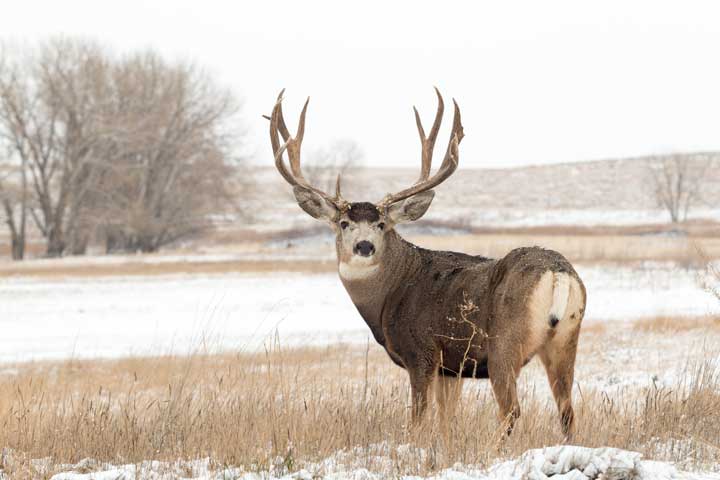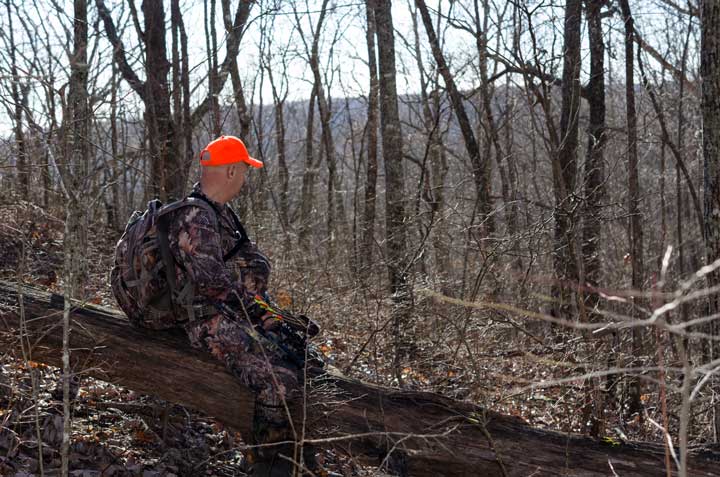If you’re a hunter, learning about a deer’s sleeping patterns is critical. After all, when a deer beds down, it’s nearly impossible to find it. A deer needs to be awake and moving in order for a hunter to target it, so knowing its sleeping habits can be extremely helpful.
As a hunter myself, I’ve learned that the question, “when do deer sleep?” is a bit more complicated than it first sounds. But don’t worry – we’ll get into the details below.
When Does a Deer Sleep?
For the most part, deer bed down during the day when the sun is out. Because of this fact, deer are considered nocturnal animals since they are active during the night.
The average deer will sleep about 12 hours during the day. They often move their locations throughout the day, getting their rest in chunks.
Where Do Deer Sleep?
In order to protect themselves from potential predators, deer often move their sleep spot throughout the day. They like to bed in large fields with lots of tall grass and foliage because it provides cover and hides them.
A deer may also curl up in thick bushes or weeds, or they find areas in thick woods with lots of low-hanging trees.
Bedded deer can be found sleeping alone or in a group.
How Does a Deer Sleep When it Rains?
A deer may move when rain clouds roll in, but they won’t go very far. Deer are creatures of nature and live in the outdoors, so they aren’t quite as easily scared off by the rain as humans are.
In fact, it’s not uncommon for you to find a deer grazing in a field during a steady downpour. A rainstorm is a perfect opportunity for deer to move without being tracked by a predator, so many deer will stay active during bouts of rain.
However, because deer sleep mostly during the day, they may seek shelter anyway simply for rest and protection.
Most species of deer, like the whitetail, will hide under a ridge. When it comes time to bed down, a deer may go under a pine tree or hide in its usual shrubs.
How Do Deer Sleep in the Snow?
Unlike some animals, deer do not hibernate. So, when the winter comes (and with it, the snow), deer usually find warm places to sleep or hide – especially at nighttime when the temperature drops.
When it snows, a deer may find shelter and sleep beneath coniferous trees such as pines. The trees’ dense foliage can shield them from the falling snow while also hiding them from predators.
Do Deer Sleep During the Night?
Although mainly a nocturnal species, deer will take the opportunity to rest at nighttime, too. However, their main goal is to hide and stay alive. A deer has better vision at night than it does during the day, but it’s their sense of smell that will alert them – even if they do fall asleep.
A deer will sleep at night in order to preserve its energy. They remain hidden in very dark places and stay as silent as possible in order to stay alive.
Some deer will gather in small groups to sleep together at night, using each other as protection. A deer will sleep anywhere from 30 seconds to a few minutes at a time, followed by short spurts of alertness. This cycle only lasts for 30 to 45 minutes and they never go into a deep sleep.
During Which Months Are Deer Active?
Whitetail deer are one of the most common breeds of deer, so we will focus on the questions of “when do whitetail deer sleep?” and related issues. This large population of deer spreads across North America and has different times of the year during which they are most active.
You can expect to see a lot of deer during the summer months through to September, as there is plenty of food available to them. While crops are plentiful from June to August, September yields the acorns that deer love so much.
Breeding season is another very active time of the year for whitetail deer. This season, which is called “the rut,” happens during the first half of November. Though, in more southern states, it lasts until December and January. These months are popular for deer hunting.
Following the rut, deer will replenish their calories and prepare for the winter, entering into a season of feeding similar to summertime.
During the winter, deer may not be as prevalent, but they still need to eat. While not as active, they can still be found near large and obvious food sources – usually in large groups.

Do Deer Always Stay in the Same Place?
Deer are creatures of habit, so once it finds a safe and comfortable area to bed, there’s a good chance it will return there over and over again for long periods of time. Even if a deer isn’t bedding in the same exact location, there’s a good chance it’s staying in one particular territory.
Where Do Mature Bucks Hang Out?
In simplest terms, you can find a mature buck where there are three different things:
- Food
- Water
- Cover
When picturing deer, many people see the females hiding in the brush while seeing a buck walking proud and tall through the fields. The truth is that bucks bed down too, so learning their bedding habits can help you find one.
Every buck has its own bedding preference, but here are a few locations where you’re likely to spot one:
- Marsh Edges
- Swamp Interiors
- Ridge Points
- Big Woods
- Islands of Trees
- Crop Field
These are just a few of the many places these wild animals like to bed down. If you find any of these with a food and water source nearby, you’re sure to be in luck.
Do Deer Take the Same Path All the Time?
Again, due to a deer’s desire for habit, it’s likely that one deer will follow a pretty particular timeline for daily activities and routes.
However, deer are intelligent creatures who will switch up their paths if they sense factors like weather or predators in the area. Mating season can also cause deer to change their daily habits.
As cautious animals, deer will change their common paths during hunting season, and a deer will rarely cross a wide-open field lacking vegetation for coverage. They also tend to travel against the wind.
When Is the Best Season To Hunt Deer?
The best time of year to hunt deer is during the fall and winter. From about October to December, you can expect the deer population to be fairly active. Between mating season and the search for winter food sources, daytime activity increases and deer become more prevalent.
Most prepared hunters like to take to the woods right around mid-fall. Because hunters are becoming active, deer will regulate their feeding times a little more. You can expect them to feed around dusk, noon, or early in the morning.
During the mating season, which begins in October and lasts until December, bucks especially become far more active. Their testosterone levels are driving their actions, which makes them overall less cautious and more erratic.
Once the winter hits, deer are looking for food anywhere they can, which causes them to spread out over large areas and increase their daily activity during the day.
Additionally, some hunters like to hunt during a full moon, because it means more light at nighttime and the possibility for more active deer than usual. Midday is also another solid time to hunt.
When Are Bucks Killed Most Often?
During the early season, hunters can have great success killing bucks during early morning hunts. A mature buck is likely to move early on in order to access food and water, so setting up near known bedding can lead to a fruitful experience.
Likewise, evening hunts are also productive because a buck will rise from his daytime bedding and start to become more active as the sun goes down.

When Is the Best Time to Hunt During the Rut?
A hunter can hunt each phase of the rut. There are technically six different phases of the rut:
- Pre-Rut
- Seeking Phase
- Chasing Phase
- Tending Phase
- Post-Rut
- Second Rut
These phases span from early October to mid-December, and you can hunt during any one of them. Many hunters agree that it gets tougher to hunt during the later phases because most deer have had human interactions and are now behaving more cautiously.
Most hunters prefer to hunt the Chasing Phase as “the rut,” despite the fact that all of these phases are a part of the rut. During this phase, bucks are chasing does and preparing to mate, so they’re extremely active and easier to find.
Deer are also more responsive to deer calling during and decoys during this phase since they’re all naturally looking to pair up and a buck has peak testosterone levels.
Some hunters also like to hunt during the Seeking Phase, as bucks begin to move more, and calling tactics may also start to work.





I want to learn all I can about this for mule deer habits. Is there more good reading on this? Thanks!!!!
Hi Tim, that’s a very good question (and idea ).
).
I have heard some of my acquaintances speaking highly about this book here, but I don’t have personal experience with it: https://amzn.to/3m44ntV
I think it may be worth it, as the price is not very high
Let me know what you think if you buy it, please.
You bet! Thanks again!
Thank you!